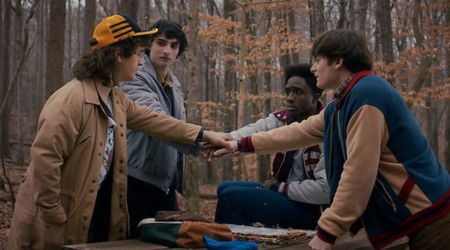Streaming platforms set to radically alter viewing patterns with shorter episodes, crisp storylines, multiple endings and more

It had to happen. With cable television following the way of the radio, we are streaming shows on our smartphones, tablets, and laptops. The CNBC All-American Economic Survey 2018 found that 57% of Americans used a paid streaming service with Netflix dominating with a market share of 51 percent, Amazon Prime at 33 percent and Hulu at 14 percent.
With a growing number of "cord-cutters" and with major networks realizing this new reality, we are now witnessing the "streaming wars" after years of having Netflix, Hulu and Amazon as the only 'proper' streaming channels, serving up original content.
As we change the medium through which we consume media, we are also going to see rapid changes in not only how content is delivered but also how it is created and tailored to fit this new paradigm. If the "Medium is the message", what are the big trends we can expect?
Shorter seasons and episodes
Streaming has meant bingeing. In this wonderful world of instant gratification, there is no waiting for "next week's episode." But this also means viewer fatigue (remember "Netflix bloat"?) and shorter attention spans. When viewers have to choose between a show with six or eight episodes in one season that they can polish off in one sitting on a lazy Sunday or watch on their smartphones when they commute and a "regular" show that requires the committed slog to watch anywhere between 13 to 22 one-hour episodes in one season, guess which show will get more clicks?
This is precisely why runtimes of episodes will get shorter, with crisper, tighter storylines. There will be no "filler episodes" (thank goodness) and each "season" will have no more than eight or nine episodes. Primes examples are shows like Tim Robinson's 'I Think You Should Leave' that had six 12-minute episodes, 'Fleabag' with its two seasons of six episodes each with the approximate runtime of 26 minutes per episode, or Netflix's 'Love, Death & Robots' anthology with stand-alone episodes with short runtimes of six to 17 minutes.
Shorter content is also cheaper to produce even if you have high production values and a platform like Netflix can bankroll several such projects and work with many new show creators, increasing their chances of having a hit that will get them more subscribers. Quibi is based solely on this idea with directors like Steven Spielberg, Sam Raimi, Antoine Fuqua and Catherine Hardwicke creating series with 10-minute episodes, starting with 'Spielberg’s After Dark' anthology series.
Going mobile
The great part about streaming is that you can watch it across devices. But even if we start to watch shows on other screens, we will probably finish watching it in our beds, on our smartphones. In 2019, mobile will surpass TV as the medium attracting the most entertainment minutes among U.S. viewers with nearly half of the millennials doing at least some of their video viewing from a smartphone or tablet. Gen Z represents an even greater affinity for watching shows on their smartphones.
While millennials still turn to connected TVs when they binge-watch for several hours, many Gen Z-ers (the fastest-growing generation group in the U.S) prefer their smartphones. According to a survey, 40% of Gen Z-ers watched Netflix "mainly on mobile", compared to only 22% of millennials. This means as Gen Z "grows up", instead of laptops or TV screens, the smartphone screen will become the preferred choice to access content on streaming platforms.
Netflix is already experimenting with how to improve video quality on-the-go while others, like Australia's groundbreaking show 'Content', are experimenting with "vertical video" tailored for smartphones. The much-hyped "mobile-only" Quibi will also, supposedly, allow viewers to watch their content in either the vertical or the horizontal orientation.
More limited series
Yes, everybody hated the fact that 'The OA' was canceled after two seasons with angry subscribers trending #CancelNetflix on Twitter. But get used to it. Show creators with a longer story arc for their show will have to get used to wrapping up their narratives in two to three seasons tops. Why? Blame it on the subscription model.
Launching new shows creates more hype (and adds more new subscribers) that make up for the few disgruntled fans of an old show threatening to cancel. You can bid goodbye to never-ending series like 'Law & Order SVU', 'NCIS' or 'Supernatural'.
The CW's 'Supernatural' did gain a new legion of fans, thanks to its presence on Netflix, and similar long-running series (including in foreign languages) will continue to be bought by streaming platforms to boost their catalogs. However, the commissioning of original content like a 'House of Cards' or 'Orange Is the New Black' with seven to eight seasons is highly unlikely.
Niche content
In the streaming wars, one of the clear front runners is Disney+ with most of the major superhero and sci-fi franchises in their kitty. It is the one streaming platform that subscribers will be tempted by because of the comprehensive content it provides in one niche genre, unlike an Apple Plus TV, NBCU Peacock or an HBO Max. Netflix has profited for years from shows like 'Friends', 'The Office' and 'The Big Bang Theory' because it worked like an aggregator platform - one service to access shows from multiple networks. With these shows now being split between the new streaming platforms, viewers are unlikely to subscribe to a new streaming service just because of one or two "old favorites".
Interactivity
When it comes to interactivity, the first thing that comes to mind is, of course, Netflix's 'Bandersnatch' that allowed viewers to actively participate in how their streaming content played out. But there is another aspect that will increasingly come into play as we get used to streaming TV series. Unlike traditional TV shows that were set in stone once they were aired, with no way to edit the broadcasted content (much like how traditional print media once functioned), streaming platforms have the advantage of 'tweaking' aspects of a show based on viewer feedback.
Just like digital news can be updated with new information and feedback, shows will also be edited based on viewer feedback. We have seen a hint of this future with Netflix experimenting with four different episode sequences for their anthology series 'Love, Death & Robots' to see which sustained viewer interest the most.










